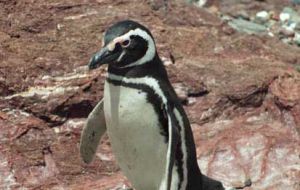MercoPress. South Atlantic News Agency
Stray Magellanic penguin swims 5.000 kilometres to Peru
 Off course: The Magellanic penguin
Off course: The Magellanic penguin A Magellanic penguin whose natural habitat is the extreme south of Patagonia and the Falkland Islands has strayed thousands of miles and swam all the way to Peru's Paracas national reserve.
Native of the Strait of Magellan and surrounding area, the penguin appears to have made the 5.000 kilometres journey on its own. Apparently he "got off course" to end up just 14 degrees south of the equator. Sadly however, the Magellanic penguin's tale may not have a happy outcome since the area where he has ended up is home to 4,000 Humboldt penguins and scientists fear they will probably reject the outsider. David Orosco, a biologist, said: "Conditions in the park are not the ones it is used to. They usually seek out their own species, and it could suffer discrimination." Magellanic penguins usually travel in large flocks while searching for food but this one somehow went astray. "It seems he was disoriented and got lost in the sea due to the different ocean currents" said Wilder Canales, head of the Paracas reserve. "In his endless search for food, he casually moved up to our shores, something that has never happened before." The penguin, which was found by a fisherman, suffered only a small wound to one wing on its epic solo journey. Experts say it is almost unheard of for them to stray so far from the breeding grounds. But this wandering penguin may yet go home. Mr Orosco said he was trying to contact colleagues in Chile to arrange a return. "It would be better for it to go back to Chile," he said. The Magellanic Penguin (Spheniscus magellanicus) has a world population of 1.5 million breeding pairs. They lay two eggs of equal size during October, and chicks fledge in February. During incubation adults may travel up to 500 kilometers to forage, but when the chicks hatch they generally remain within 30 kilometers of the nest. Diet comprises of roughly equal proportions of fish, squid and Lobster Krill, taken at depths of less than 50 meters. Breeding sites are abandoned between April and September during the winter migration. Adults can breed at 4 years of age, and can live to 20 years.




Top Comments
Disclaimer & comment rulesCommenting for this story is now closed.
If you have a Facebook account, become a fan and comment on our Facebook Page!